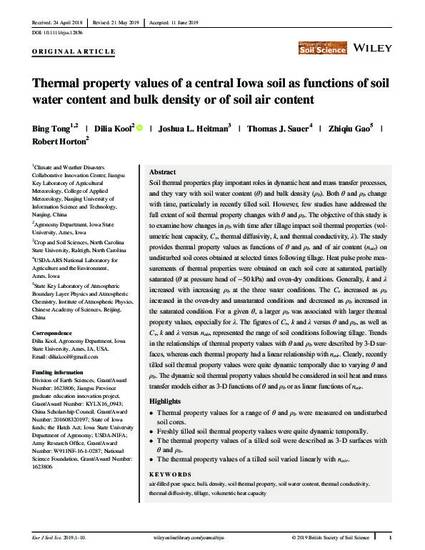
Soil thermal properties play important roles in dynamic heat and mass transfer processes, and they vary with soil water content (θ) and bulk density (ρ b). Both θ and ρ bchange with time, particularly in recently tilled soil. However, few studies have addressed the full extent of soil thermal property changes with θ and ρ b. The objective of this study is to examine how changes in ρ b with time after tillage impact soil thermal properties (volumetric heat capacity, C v, thermal diffusivity, k, and thermal conductivity, λ). The study provides thermal property values as functions of θ and ρ b and of air content (n air) on undisturbed soil cores obtained at selected times following tillage. Heat pulse probe measurements of thermal properties were obtained on each soil core at saturated, partially saturated (θ at pressure head of −50 kPa) and oven‐dry conditions. Generally, kand λ increased with increasing ρ b at the three water conditions. The C v increased as ρ bincreased in the oven‐dry and unsaturated conditions and decreased as ρ b increased in the saturated condition. For a given θ, a larger ρ b was associated with larger thermal property values, especially for λ. The figures of C v, k and λ versus θ and ρ b, as well as C v, k and λ versus n air, represented the range of soil conditions following tillage. Trends in the relationships of thermal property values with θ and ρ b were described by 3‐D surfaces, whereas each thermal property had a linear relationship with n air. Clearly, recently tilled soil thermal property values were quite dynamic temporally due to varying θ and ρ b. The dynamic soil thermal property values should be considered in soil heat and mass transfer models either as 3‐D functions of θ and ρ b or as linear functions of n air.
Available at: http://works.bepress.com/robert-horton/129/

This article is published as Tong, B., D. Kool, J. L. Heitman, T. J. Sauer, Z. Gao, and R. Horton. "Thermal property values of a central Iowa soil as functions of soil water content and bulk density or of soil air content." European Journal of Soil Science (2019). doi: 10.1111/ejss.12856.